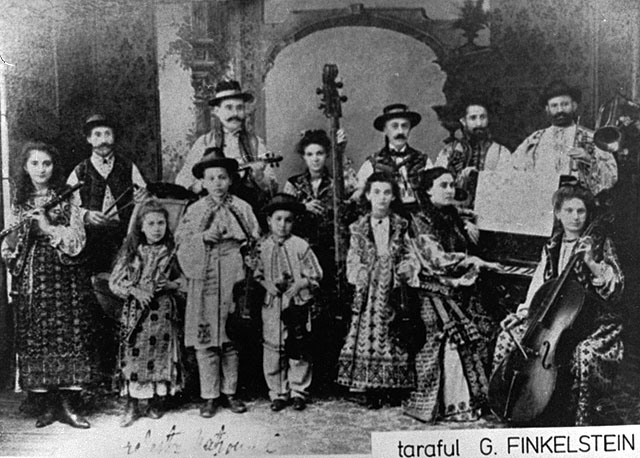
Music is in the heart of every civilization. In the Jewish history it is a language in which joy and pain are expressed, both in the prayers in the synagogue and at home. It is a language with roots in the past and relates to contemporary music, mirroring the changing social and political landscapes. Thus, the origins of the Jewish communities are reflected in their religious musical traditions: in the Ashkenazi and the Sephardic rites and chants, which included various congregations, according to their places of origin. While in other communities of the Diaspora, especially in Ashkenaz, rabbinical restrictions regarding instrumental music, dance and theater prevented Jews from developing these fields, in Romania, since mid-nineteenth century Jews have had an impressive cultural output, especially in klezmer music.
Klezmer music emerged out of a larger East European Jewish musical culture that included cantorial music, Hassidic Nigns and Yiddish theater music, and it also borrowed from the local folk music and from Cosmopolitan European music forms.
Moldova played an important role in the development of modern klezmer music, and from the mid-nineteenth century on, klezmer music spread from Moldova, Bessarabia and Transylvania, all within or neighboring present day Romania, to areas north and west. At that time, the repertoire of klezmer music consisted of instrumental wedding songs, table songs, and instrumental versions of liturgical music, usually played in duet by violin and flute with cimbalom (tsimbl) accompaniment.
The Jewish repertoire of Hasidic inspiration and klezmer music were very popular in the Yiddish Theater established by Avram Goldfaden in Iaşi in 1876. In Iaşi, there were several klezmer families, among them, the Lemesh family who also played in Avram Goldfaden's Yiddish Theater orchestra at the Pomul Verde wine cellar, the Bughici family band, the Segal family, and the Weiss family.
In Transylvania, that was part of Hungary before 1920, we find fewer traces of Jewish musicians. One reason is the different social development of Transylvania’s Jews under the Austro-Hungarian monarchy. Jews were granted civil rights in 1867, and even before that date were accepting social integration in Hungarian society. In 1868 Hungary’s Jewish communities split into Neolog (sort of "Reform") and Orthodox, with some communities remaining as "status quo". The communities in Cluj, Arad, Sibiu, and Timişoara that were mainly Neolog, adopted Hungarian language in place of Yiddish. Jews were great patrons of Magyar notak (Hungarian folk music), and gypsy musicians were hired for Jewish weddings, and played some Jewish songs, such as "Belz," various Yiddish theater songs and a few Sabbath zmiros, while providing Hungarian czardas music for dancing.
Only by mid nineteenth century had public performances of opera, symphonic music, and chamber music began to spread in Romanian society, encouraged by musical societies, music publishing firms and conservatories which produced a new, modern class of professional concert musicians.
Romania’s discovery of Jewish music and Jewish musicians was but one part of a two-way cultural exchange. As the forces of acculturation and gentrification gained ground in mid nineteenth-century Jewish society, in Romania, as in other east European countries, music became a prime professional ambition and cultural passion for Jews, and they played an active role in this cultural process, as composers, performers, critics, teachers, musicologists, producers and publishers.
Besides, following the example of Central European Jews, the Jewish middle class in Romania embraced amateur music study and chamber performances, particularly the practice of Jewish women playing the piano.
In the second half of the 19th century, when the first musical schools in Romania were established, together with founders such as George Ştefănescu, Constantin Dimitrescu, George Dima and Gavriil Musicescu, Mauriciu Cohen Lânaru (1849-1929), a Jewish composer and music critic was active.
Among Jewish composers of concert music that became prominent in the twentieth century are, Abraham Levy Ivela, Ludovic Feldman, Max Eisikovits, Harry Maiorovici, Alfred Mendelssohn, Dumitru Bughici , and Anatol Vieru.
Avram Goldfaden, the father of Jewish theater, who founded in Iaşi the Yiddish theater, was also a composer of Jewish music, and Haim Schwartzmann, another composer of Jewish music, was one of the most active composers and conductors of the Jewish theater in Bucharest.
Synagogue cantors played an important role in the development of Jewish music culture in Romania. Albert Della Pergola cantor at the Templul Spaniol (Spanish Temple) in Bucharest was a great promoter of Sephardic music.
Harry Brauner was an outstanding musicologist, specializing in Romanian and Jewish folk music, and Alfred Hoffman was a prominent musical critic.
Great performers who became well known and had international careers include pianists Clara Haskil, Mândru Katz, and Radu Lupu; violinists Silvia Marcovici and Ştefan (Istvan) Ruha, and conductors Sergiu Comissiona and Mendi Rodan.
H. Mairovici, "MUZICA," in: Coordinare generala: Acad. Nicolae Cajal , Dr. Hary Kuller, Contributia Evreilor din Romania la Cultura si Civilizatie, Partea a V-a ARTE,SPECTACOLE, Bucuresti, 1996, 358-365
Ezra Mendelsohn, “On the Jewish Presence in Nineteenth-Century European Musical Life,” Studies in Contemporary Jewry 9, 1993
Klára Móricz, “Jewish Nationalism in Twentieth-Century Art Music,” Ph.D. diss., University of California, Berkeley, 1999
Zev Feldman , Klezmer : music, history and memory. New York, NY: Oxford University Press, 2016, 111–3
Mark Slobin, Fiddler on the move : exploring the klezmer world. Oxford: Oxford University Press, 2000
Ada Brumaru cap Muzică în N.Cajal, H. Kuller, - Contribuția evreilor din România la cultură și civilizație Hasefer, București 2004
Iosif Sava Muzicieni evrei de la noi și din lume: Muzicanții pe acoperi